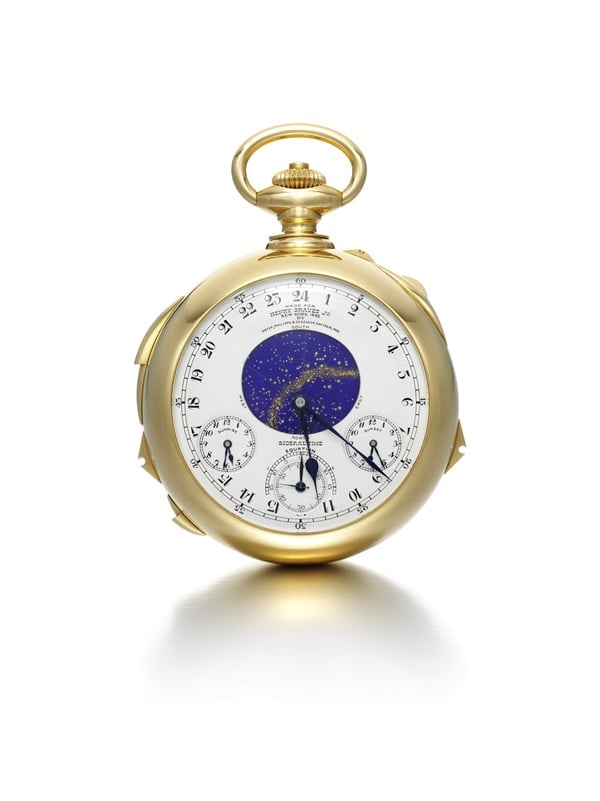Auctions
Sheikh Al-Thani’s Watch Sells for $24 Million After His Mysterious Death
The watch was apparently turned over to Sotheby's to cover auction house debts.

The watch was apparently turned over to Sotheby's to cover auction house debts.

Alexander Forbes

The watch of Sheikh Saud bin Mohammed Al-Thani, the man once considered the world’s biggest art collector and who died at his London home on November 9 (see: “World’s Biggest Art Collector Sheikh Saud bin Mohammed Al-Thani Dies at Age 48“), has just sold at Sotheby’s Geneva for $24 million. The estimate on the watch, the Henry Graves Supercomplication by Patek Philippe, was rumored to be $15.6 million, as reported by Bloomberg last year, but before the sale the estimate had been only given upon request.
According to a press release, there were five bidders for the watch, which finally went to an anonymous bidder “after 15 minutes of suspense.”
In and of itself the sale is noteworthy for its remarkably odd timing. But what the fancy timepiece reveals about Al-Thani and his super-complicated history with auction houses is perhaps even more interesting.
According to Sotheby’s financial statements, obtained by Doha News, the collector had turned his watch (which has been touted as the world’s most expensive) over to the auction house, along with nearly $70 million in other assets to help cover an enormous amount of debt he had accrued by defaulting on payments for various purchases.
The cousin of Qatar’s Emir, the collector was a regular on the auction house floor and at the annual TEFAF art fair in Maastricht when not embroiled in controversy and conflicts with auction houses, dealers, and even his own government.

Henry Graves Supercomplication by Patek Philippe.
Courtesy of Sotheby’s
Al-Thani was reportedly particularly fond of photography. He went on several lavish spending sprees and had his portrait taken by lions of the field Richard Avedon and Irving Penn. He even founded the so-called Al-Thani Award for Photography, which has attracted tens of thousands of applicants each year. But when it came to big-ticket purchases, antiquities and collectibles were said to be among his greatest weaknesses.
Adding to the growing posthumous profile of the collector, BBC arts editor Will Gompertz chimed in with a rather upbeat assessment on Tuesday. “When he was in town—so the rumour goes—art dealers and auction houses would dust down their best stuff, add a nought or two, and await his visit,” wrote Gompertz.
But according to Gompertz, what made Al-Thani rise above the other collectors wasn’t only “the vast sums of money he was willing to spend”; it was also that he purchased across categories and was relentless when bidding on the things he wanted. “There are stories of items valued at a few thousand pounds that would suddenly be nudging seven figures because the Sheikh and an underbidder were locked in an act of brinkmanship.”
Such acts of conspicuous consumption may have gotten out of hand, according to numerous accounts. In 2012 Al-Thani allegedly defaulted on a $19.7 million purchase of a group of coins from the so-called Prospero Collection. At the time, representatives for the dealers involved in the sale—A.H. Baldwin and Sons Ltd, Dmitry Markov Coins and Medals, and N&M Numismatics LLC—told the Daily Mail that the sheikh was like an “inveterate gambler”—in other words alleging that he was addicted to the very act of bidding and spending large sums of money.
“He bids, wins and then doesn’t pay,” said the dealers’ legal representative, Jeffrey Gruder. “One can only conclude that this is a person acting dishonourably and disreputably. He is bidding when he knows he’s not going to be able to pay.”
Gruder claimed that, among other lesser debts, Al-Thani owed $42 million to Sotheby’s and £4.3 million to Bonhams. The sheikh’s lawyers denied the allegations of further debts and said that efforts had been made to pay for the coins.
A portion of the sheikh’s assets were later frozen due to the claims against him.
According to Bloomberg, Al-Thani was also sued by his London lawyer for failing to pay $419,400 in legal fees.
Doha News reported that $15 million of his assets were frozen at the time when the Supercomplication watch was turned over to help settle the debt.
All this occurred one to two years after Sheikh Al-Thani reemerged on the art scene in 2011 after a brief stint under house arrest. His collecting is said to have diminished during the period but still reached several hundred million. At the time, reports claimed that he had been cleared of all charges that arose in 2005, when he was accused of having misused state funds.
Speaking to ArtNews in 2005, Dr. Massumeh Farhad, curator of Islamic art at the Freer and Sackler Galleries of Art said, “He single-handedly inflated the market. If I were the government I would want to make sure those were fair prices.”
Al-Thani served as Qatar’s president of the National Council for Culture, Arts and Heritage from 1997 to 2005 but was allegedly ousted from that post due to the claims against him. He famously spent over $1 billion on art during the period, a feat accomplished once again between 2011 and 2012 by his cousin, the Qatari Emir’s daughter Al-Mayassa bint Hamad bin Khalifa Al-Thani.